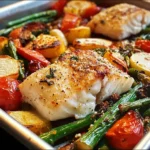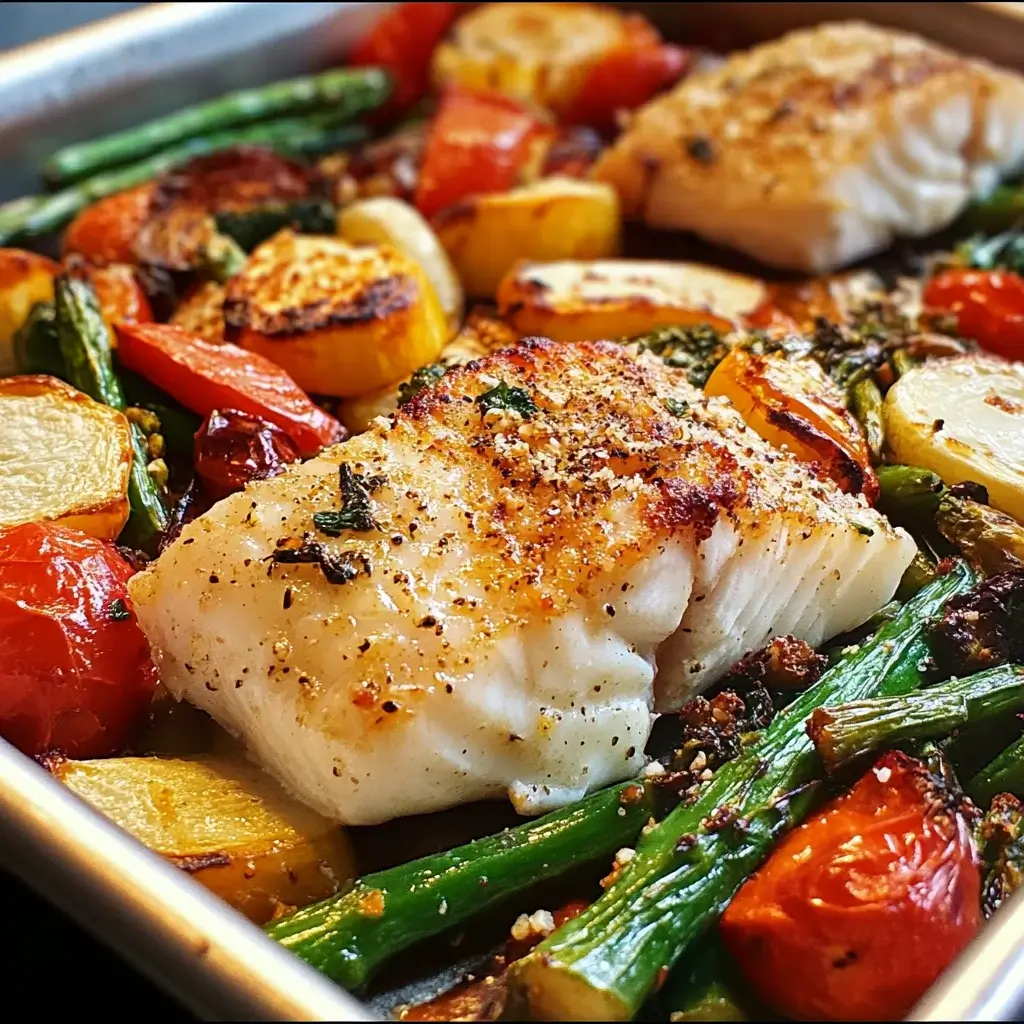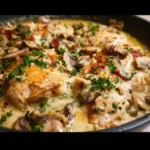This Easy Baked Fish and Veggies recipe has become an absolute lifesaver in our household. I remember the first time I made it; I was short on time, staring blankly into the fridge, and dreading a complicated meal prep. I grabbed some white fish fillets, a medley of colorful vegetables, and a few pantry staples. The result? A deliciously flaky fish, perfectly tender-crisp vegetables, and a chorus of “This is amazing!” from my family, including my notoriously picky eater. It was so incredibly simple, yet packed with flavor and felt wonderfully wholesome. Since then, it’s been on regular rotation, adapting to whatever veggies are in season or whatever fish looks freshest at the market. It’s the kind of meal that makes you feel like a kitchen hero without any of the fuss, proving that healthy and delicious can indeed go hand-in-hand with minimal effort.
Ingredients for Easy Baked Fish and Veggies
- 4 (6-ounce) firm white fish fillets: Such as cod, halibut, tilapia, or snapper. Pat them dry for best results. These provide a lean source of protein.
- 1 pound small new potatoes or fingerling potatoes: Halved or quartered if large. Their waxy texture holds up well to roasting.
- 1 large red bell pepper: Cored, seeded, and cut into 1-inch chunks. Adds sweetness and vibrant color.
- 1 large yellow or orange bell pepper: Cored, seeded, and cut into 1-inch chunks. Complements the red pepper in flavor and appearance.
- 1 medium red onion: Cut into 1-inch wedges. Roasting mellows its sharpness and brings out its sweetness.
- 1 pound broccoli florets: Cut into bite-sized pieces. Adds a nutritional punch and a lovely green hue.
- 4 tablespoons olive oil, divided: Extra virgin olive oil is preferred for its flavor and health benefits.
- 2 cloves garlic, minced: Adds aromatic depth to the dish.
- 1 teaspoon dried oregano: A classic Mediterranean herb that pairs beautifully with fish and vegetables.
- 1/2 teaspoon dried basil: Complements the oregano and adds another layer of herbaceous flavor.
- 1/2 teaspoon salt, or to taste: Enhances all the flavors.
- 1/4 teaspoon black pepper, or to taste: Adds a touch of warmth.
- 1 lemon: Half juiced, half cut into wedges for serving. Brightens the dish.
- Optional: Fresh parsley or dill, chopped: For garnish, adding freshness at the end.
Step-by-Step Instructions for Your Perfect Baked Fish and Veggies
- Preheat and Prepare: Preheat your oven to 400°F (200°C). Line a large, rimmed baking sheet with parchment paper for easy cleanup. This also helps prevent sticking.
- Prep the Vegetables: In a large bowl, combine the halved/quartered potatoes, bell pepper chunks, red onion wedges, and broccoli florets.
- Season the Vegetables: Drizzle the vegetables with 3 tablespoons of the olive oil. Add the minced garlic, dried oregano, dried basil, half of the salt (1/4 teaspoon), and half of the black pepper (1/8 teaspoon). Toss everything together until the vegetables are evenly coated.
- Roast the Vegetables (First Round): Spread the seasoned vegetables in a single layer on the prepared baking sheet. Try not to overcrowd the pan; use two sheets if necessary to ensure even roasting. Roast for 15-20 minutes, or until the potatoes begin to soften and the vegetables start to get tender-crisp.
- Prepare the Fish: While the vegetables are roasting, pat the fish fillets dry with paper towels. This helps them to bake nicely rather than steam.
- Season the Fish: Drizzle the remaining 1 tablespoon of olive oil over the fish fillets. Season them with the remaining salt (1/4 teaspoon) and black pepper (1/8 teaspoon). Squeeze the juice from half the lemon over the fillets.
- Add Fish to the Pan: After the initial 15-20 minutes of roasting, carefully remove the baking sheet from the oven. Make space amongst the vegetables and nestle the fish fillets onto the baking sheet in a single layer.
- Bake Together: Return the baking sheet to the oven. Bake for another 10-15 minutes, depending on the thickness of your fish fillets. The fish is cooked when it is opaque and flakes easily with a fork. An instant-read thermometer inserted into the thickest part of the fish should register 145°F (63°C). The vegetables should be tender and slightly caramelized.
- Garnish and Serve: Carefully remove the baking sheet from the oven. If desired, sprinkle with fresh chopped parsley or dill. Serve immediately with lemon wedges on the side for squeezing over the fish and vegetables.
Nutrition Facts: A Healthy Delight
- Servings: 4
- Calories per serving: Approximately 450-550 calories (This can vary based on the exact type and size of fish fillets and the specific vegetables used).
- Lean Protein Powerhouse: Each serving provides a significant amount of high-quality protein from the fish, crucial for muscle repair, immune function, and satiety.
- Rich in Omega-3 Fatty Acids (especially with fish like cod or snapper): These healthy fats are known for their heart health benefits, reducing inflammation, and supporting brain function.
- Excellent Source of Vitamins & Minerals: Thanks to the colorful array of vegetables, this dish is packed with vitamins like Vitamin C (from bell peppers and broccoli), Vitamin K, and various B vitamins, plus essential minerals like potassium.
- Good Source of Fiber: The vegetables and potatoes contribute dietary fiber, which aids in digestion, helps regulate blood sugar levels, and promotes a feeling of fullness.
- Relatively Low in Saturated Fat: Using olive oil and lean fish keeps the saturated fat content in check, making it a heart-healthy choice.
Preparation Time: Quick and Efficient
- Total Preparation & Cooking Time: Approximately 45-55 minutes
- Active Prep Time: 15-20 minutes (chopping vegetables, seasoning fish). This is where most of your hands-on work occurs.
- Cooking Time: 30-35 minutes (initial vegetable roast + combined fish and vegetable bake). This is largely hands-off, allowing you time to set the table or relax.
This recipe is designed for weeknight ease, minimizing active kitchen time while maximizing flavor and nutritional benefits.
How to Serve Your Delicious Easy Baked Fish and Veggies
This Easy Baked Fish and Veggies dish is a complete meal on its own, but here are some delightful ways to serve it and enhance the dining experience:
- Directly from the Sheet Pan (Family Style):
- For a casual and rustic presentation, bring the baking sheet (perhaps placed on a trivet) directly to the table.
- Provide serving spoons and let everyone help themselves.
- Keep the lemon wedges in a small bowl nearby.
- Individually Plated:
- Arrange a portion of the roasted vegetables artfully on each plate.
- Place a fish fillet gently on top or alongside the vegetables.
- Garnish with a sprinkle of fresh herbs (parsley, dill, or chives) just before serving.
- Place a lemon wedge on the side of each plate.
- With a Simple Grain or Starch (Optional additions):
- Quinoa: Serve alongside a scoop of fluffy quinoa for added protein and a nutty flavor.
- Couscous: Lemon herb couscous would be a fantastic complement.
- Brown Rice: For a heartier, fiber-rich addition.
- Crusty Bread: Perfect for soaking up any delicious pan juices. A slice of sourdough or a whole-grain baguette works wonderfully.
- Accompanied by a Light Sauce:
- Tzatziki Sauce: A cool, creamy cucumber and yogurt sauce is a refreshing contrast.
- Simple Lemon-Dill Yogurt Sauce: Mix plain Greek yogurt with lemon juice, chopped dill, and a pinch of salt.
- Pesto: A dollop of vibrant green pesto can add an extra layer of herbaceous flavor.
- Tartar Sauce: A classic pairing for baked fish, especially for those who love traditional flavors.
- With a Side Salad:
- A simple green salad with a light vinaigrette can round out the meal, adding more fresh greens.
- Drink Pairings:
- Crisp White Wine: A Sauvignon Blanc, Pinot Grigio, or an unoaked Chardonnay pairs beautifully with the fish and vegetables.
- Light Beer: A pilsner or a light lager.
- Infused Water: Lemon and cucumber-infused water for a refreshing non-alcoholic option.
No matter how you choose to serve it, the vibrant colors and enticing aromas of this Easy Baked Fish and Veggies will surely impress!
Additional Tips for the Ultimate Easy Baked Fish and Veggies
- Choosing Your Fish Wisely: While cod and halibut are excellent choices, don’t be afraid to experiment. Snapper, mahi-mahi, or even salmon (though it has a stronger flavor and may require slight adjustments in cooking time) can work. Always opt for fillets of similar thickness to ensure even cooking. If using thinner fillets like tilapia, reduce the fish cooking time accordingly.
- Vegetable Variety and Cooking Times: The beauty of this dish is its versatility. Feel free to swap vegetables based on season or preference. Consider asparagus spears (add in the last 10-12 minutes), cherry tomatoes (add with the fish), zucchini or yellow squash chunks (they cook quickly, so add with the fish or slightly before). Remember that harder vegetables like carrots or sweet potatoes will need a longer initial roasting time than softer ones.
- Don’t Overcrowd the Pan: This is crucial for achieving nicely roasted, slightly caramelized vegetables rather than steamed ones. If your vegetables are too crowded, they will release moisture and steam. Use two baking sheets if necessary, distributing the vegetables evenly.
- Oil and Seasoning are Key: Ensure all vegetables are lightly but evenly coated in olive oil. This helps them roast beautifully and prevents them from drying out. Don’t skimp on seasoning; salt and pepper bring out the natural flavors of the fish and vegetables. Feel free to add other spices like smoked paprika, garlic powder (if not using fresh), or a pinch of red pepper flakes for some heat.
- Perfectly Cooked Fish – The Doneness Test: The most common mistake is overcooking fish, which makes it dry. Fish is perfectly cooked when it’s opaque all the way through and flakes easily with a fork. The internal temperature should reach 145°F (63°C). Use an instant-read thermometer for accuracy, especially if you’re new to cooking fish.
- A Brief Rest for the Fish: Just like meat, fish benefits from a very short rest (a minute or two) after coming out of the oven. This allows the juices to redistribute slightly, resulting in a more tender fillet.
- Customize Your Flavor Profile: Beyond oregano and basil, explore other flavor combinations. For a Mediterranean twist, add capers and olives with the fish. For a hint of Asian flair, consider a light soy-ginger glaze for the fish and add sesame oil to the veggies. Fresh herbs like rosemary or thyme are also wonderful with roasted vegetables.
- Meal Prep Pointers: You can chop all your vegetables a day or two in advance and store them in an airtight container in the fridge. You can also mix your dried herbs and spices together. This makes assembly on a busy night even quicker – just toss, season, and bake!
Frequently Asked Questions (FAQ) about Easy Baked Fish and Veggies
- Q: Can I use frozen fish fillets for this recipe?
- A: Yes, you can use frozen fish fillets. For best results, thaw them completely in the refrigerator overnight. Before seasoning, pat them very dry with paper towels to remove excess moisture. If you’re in a pinch, some thinner fillets can be cooked from frozen, but you’ll need to add approximately 5-10 minutes to the baking time and ensure they reach the safe internal temperature of 145°F (63°C).
- Q: What are the best types of vegetables to use for sheet pan roasting with fish?
- A: Root vegetables like potatoes, carrots, and parsnips are great but need a head start. Cruciferous vegetables like broccoli, cauliflower, and Brussels sprouts roast beautifully. Bell peppers, onions, zucchini, asparagus, and cherry tomatoes are also excellent choices. Consider the cooking time: harder veggies need more time, softer ones less.
- Q: How do I prevent the fish from sticking to the baking sheet?
- A: Using parchment paper is the best way to prevent sticking and makes cleanup a breeze. Alternatively, ensure your baking sheet is lightly greased with olive oil or cooking spray where the fish will be placed. A light coating of oil on the fish itself also helps.
- Q: Can I prepare any components of this Easy Baked Fish and Veggies recipe ahead of time?
- A: Absolutely! You can chop all the vegetables up to 2 days in advance and store them in an airtight container in the refrigerator. You can also pre-mix your dried seasonings. However, it’s best to season the fish just before baking. This makes the actual cooking process very quick.
- Q: How should I store and reheat leftovers?
- A: Store leftover baked fish and veggies in an airtight container in the refrigerator for up to 2-3 days. To reheat, it’s best to use the oven or a toaster oven at around 300-325°F (150-160°C) for 10-15 minutes, or until warmed through. This helps retain some of the texture. Microwaving can work but may make the fish a bit rubbery and the vegetables softer.
- Q: Is this recipe gluten-free and dairy-free?
- A: Yes, as written, this Easy Baked Fish and Veggies recipe is naturally gluten-free and dairy-free. Always double-check your specific ingredients (like any pre-made seasonings, though this recipe uses basic herbs) if you have severe allergies.
- Q: Can I use different herbs and spices than the ones listed?
- A: Definitely! Feel free to customize the seasonings to your preference. Consider using Italian seasoning blend, herbes de Provence, smoked paprika for a smoky flavor, or a pinch of cayenne pepper for some heat. Fresh herbs like rosemary or thyme can be added to the vegetables during roasting, while fresh dill, parsley, or chives are great for garnishing.
- Q: How do I know when the fish is perfectly cooked without a thermometer?
- A: The most reliable visual cue is that the fish will turn from translucent to opaque. Gently press a fork into the thickest part of the fillet and twist slightly. If it flakes easily into layers, it’s done. If it’s still somewhat translucent or resists flaking, it needs a few more minutes. Be careful not to overcook, as it will become dry.

Easy Baked Fish and Veggies
Ingredients
- 4 (6-ounce) firm white fish fillets: Such as cod, halibut, tilapia, or snapper. Pat them dry for best results. These provide a lean source of protein.
- 1 pound small new potatoes or fingerling potatoes: Halved or quartered if large. Their waxy texture holds up well to roasting.
- 1 large red bell pepper: Cored, seeded, and cut into 1-inch chunks. Adds sweetness and vibrant color.
- 1 large yellow or orange bell pepper: Cored, seeded, and cut into 1-inch chunks. Complements the red pepper in flavor and appearance.
- 1 medium red onion: Cut into 1-inch wedges. Roasting mellows its sharpness and brings out its sweetness.
- 1 pound broccoli florets: Cut into bite-sized pieces. Adds a nutritional punch and a lovely green hue.
- 4 tablespoons olive oil, divided: Extra virgin olive oil is preferred for its flavor and health benefits.
- 2 cloves garlic, minced: Adds aromatic depth to the dish.
- 1 teaspoon dried oregano: A classic Mediterranean herb that pairs beautifully with fish and vegetables.
- 1/2 teaspoon dried basil: Complements the oregano and adds another layer of herbaceous flavor.
- 1/2 teaspoon salt, or to taste: Enhances all the flavors.
- 1/4 teaspoon black pepper, or to taste: Adds a touch of warmth.
- 1 lemon: Half juiced, half cut into wedges for serving. Brightens the dish.
- Optional: Fresh parsley or dill, chopped: For garnish, adding freshness at the end.
Instructions
- Preheat and Prepare: Preheat your oven to 400°F (200°C). Line a large, rimmed baking sheet with parchment paper for easy cleanup. This also helps prevent sticking.
- Prep the Vegetables: In a large bowl, combine the halved/quartered potatoes, bell pepper chunks, red onion wedges, and broccoli florets.
- Season the Vegetables: Drizzle the vegetables with 3 tablespoons of the olive oil. Add the minced garlic, dried oregano, dried basil, half of the salt (1/4 teaspoon), and half of the black pepper (1/8 teaspoon). Toss everything together until the vegetables are evenly coated.
- Roast the Vegetables (First Round): Spread the seasoned vegetables in a single layer on the prepared baking sheet. Try not to overcrowd the pan; use two sheets if necessary to ensure even roasting. Roast for 15-20 minutes, or until the potatoes begin to soften and the vegetables start to get tender-crisp.
- Prepare the Fish: While the vegetables are roasting, pat the fish fillets dry with paper towels. This helps them to bake nicely rather than steam.
- Season the Fish: Drizzle the remaining 1 tablespoon of olive oil over the fish fillets. Season them with the remaining salt (1/4 teaspoon) and black pepper (1/8 teaspoon). Squeeze the juice from half the lemon over the fillets.
- Add Fish to the Pan: After the initial 15-20 minutes of roasting, carefully remove the baking sheet from the oven. Make space amongst the vegetables and nestle the fish fillets onto the baking sheet in a single layer.
- Bake Together: Return the baking sheet to the oven. Bake for another 10-15 minutes, depending on the thickness of your fish fillets. The fish is cooked when it is opaque and flakes easily with a fork. An instant-read thermometer inserted into the thickest part of the fish should register 145°F (63°C). The vegetables should be tender and slightly caramelized.
- Garnish and Serve: Carefully remove the baking sheet from the oven. If desired, sprinkle with fresh chopped parsley or dill. Serve immediately with lemon wedges on the side for squeezing over the fish and vegetables.
Nutrition
- Serving Size: one normal portion
- Calories: 550






